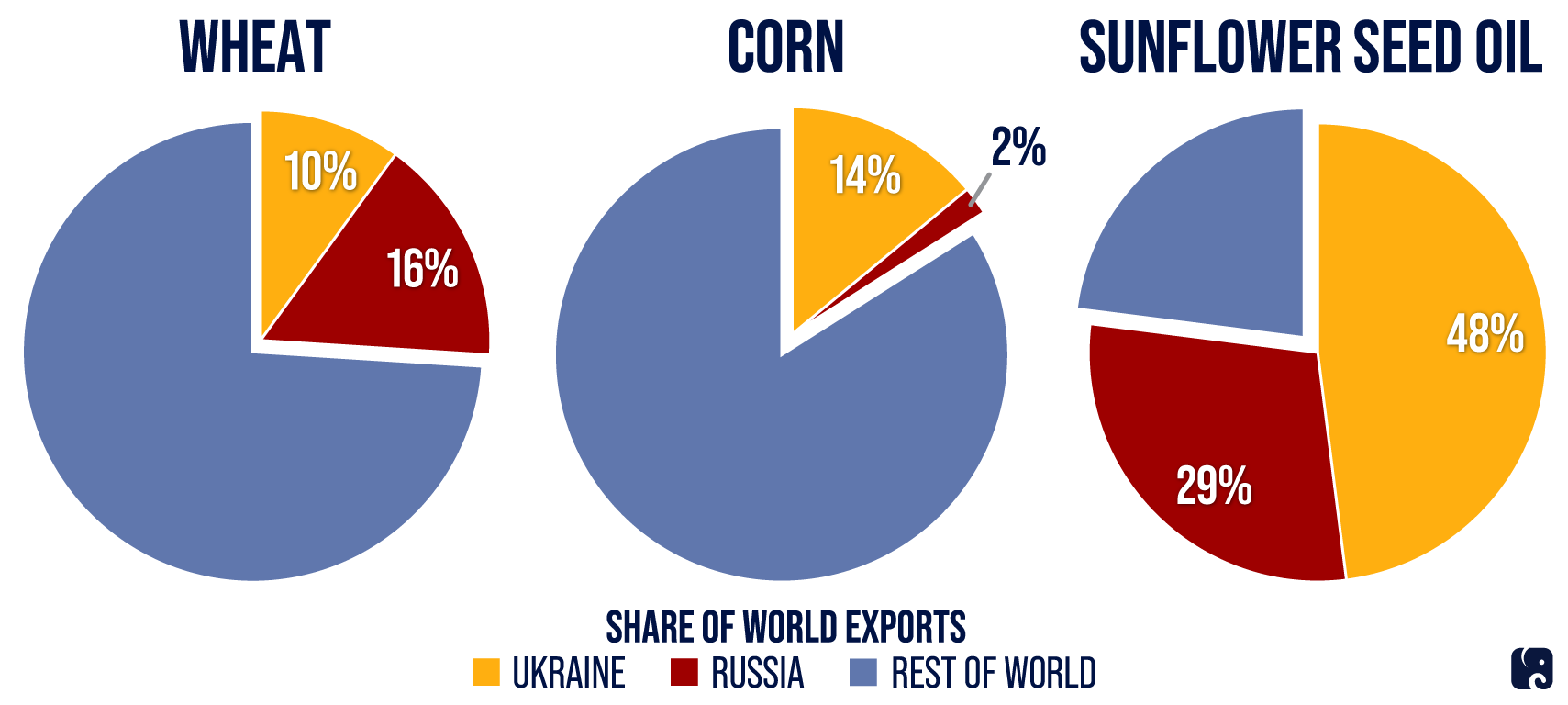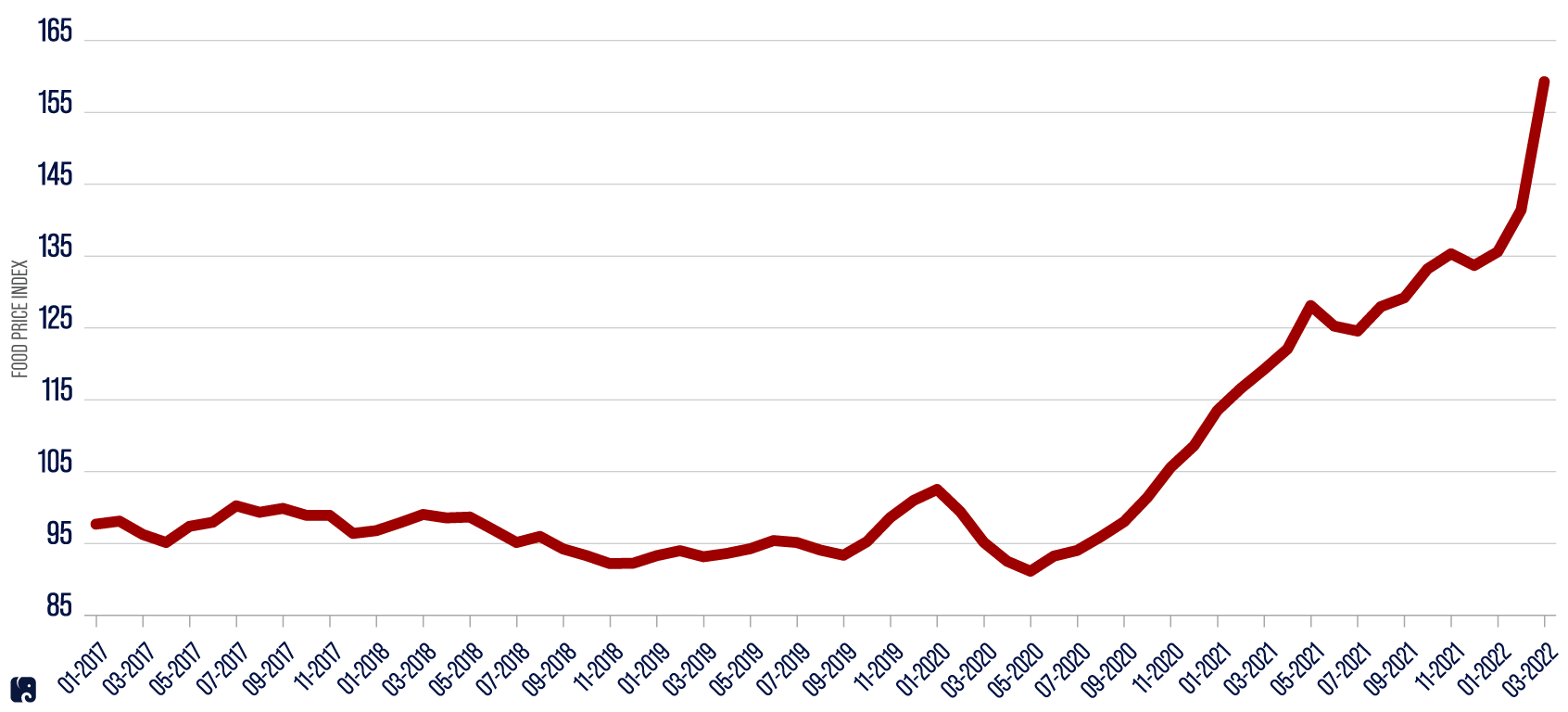Putin's Global Food Crisis
KEY TAKEAWAYS
- Together, Russia and Ukraine generally account for one-quarter of global wheat exports, three-quarters of sunflower oil exports, and one-sixth of corn exports. The region also produces raw materials used for fertilizer production.
- Russia’s invasion of Ukraine has disrupted processing and export of previously grown products and is likely to prevent spring planting in many areas of Ukraine.
- Commodity prices spiked following Russia’s February 24 invasion. These price hikes come on top of ongoing global food inflation; the food price index was up 38% from January 2020 to February 2022, then climbed another 12.7% from February to March, reaching a new record high.
Russia’s war against Ukraine has disrupted shipping and agricultural production, and it is exacerbating price inflation for commodities. A prolonged conflict could upend the food supply chain and undermine global food security.
War in the Breadbasket

Ukraine and Russia are major producers and exporters of grains and oilseeds. Typically, Ukraine supplies 48% of the world’s sunflower oil exports, 10% of the wheat, and 14% of the corn. Russia accounts for around 16% of the world’s wheat exports, 2% of the corn, and 29% of the sunflower oil. Wheat is a staple cereal grain and primary food source for 35% of the world’s population. Sunflower oil, like other vegetable oils, is used for frying and roasting; it accounts for about 9% of global vegetable oil consumption.
The region produces nitrogen, phosphate, and potassium, raw materials critical for fertilizer production. Russia is a top producer of potash and nitrogen fertilizers. According to an analysis by the American Farm Bureau Federation, Russia was the global leader in nitrogen exports in 2018. It ranked third in phosphate and potassium exports the same year.
Exports and Production Interrupted
Ukraine’s seaports – the primary means of export for its agricultural products – have not been operational since Russia began its attack. The country’s exports of grains and oilseeds dropped to just 3% of their usual monthly volume in March. In mid-April, the Ukrainian minister of agrarian policy and food said that around 1.25 million metric tons of grains and oilseeds are blocked at seaports. Russia’s attacks also have targeted infrastructure critical to commodity processing and shipping, such as major grain-export facilities.
The war is likely not only to disrupt exports of agriculture products that were previously grown and processed, but also may prevent some spring planting in parts of Ukraine. Some areas where crops would normally be sown are now under siege, and there are reports that farmers have returned in other places to find their fields mined. Other regions face shortages of fertilizer, fuel, or labor. Ukraine’s 2022 grain harvest could fall more than 54%, and its harvest of sunflower seeds could decline by as much as 42%, by some estimates.
Prices Climb
Because commodities operate in an interconnected, global marketplace, regional shocks in supply can have worldwide implications. Global supplies of many food products are sufficient to prevent shortages, but an unanticipated hole in global production and the expected drawdown of stockpiles has already pushed prices higher across the supply chain. Food commodity prices were already elevated as a result of pandemic supply chain snarls, and they have climbed even higher following Russia’s February 24 invasion.
The U.N. Food and Agriculture Organization’s food price index, which measures changes in international prices of food, was up 38% from January 2020 to February 2022, then climbed another 12.7% from February to March, reaching a new record high. The cereal price index, which reflects price hikes in wheat and grains, climbed 17.1% in March, and the vegetable oil index jumped 23.2%. The International Monetary Fund has predicted that food costs will increase globally by 14% in 2022 and continue climbing into next year.
Global Food Prices, Already Rising, Spike During the War

Global Food Security Compromised
Food supply-chain shocks disproportionately harm people in relatively poor countries that rely on food imports. Yemen, which sourced 58% of its wheat imports from Ukraine and Russia, imported 125 kilograms of wheat per person in 2018. At approximately 3,400 calories per kg of wheat, this equates to relying on imports for more than 1,100 calories a day – about 80% of the average calories consumed by a person in Yemen each day. Ukraine exported 382 kg of wheat per capita that year.
Rising food prices are also linked to increases in global poverty. While citizens of more developed countries have higher nominal food expenses, families in less-developed countries must devote a significantly larger share of their income to food. There is also an inverse relationship between the proportion of household expenses attributable to food and per capita calorie availability, a proxy for the likelihood of people going hungry. The Center for Global Development estimates that at least 40 million people will move into extreme poverty as a result of the food price spike following Russia’s invasion of Ukraine.
Senators have expressed interest in providing additional global food aid resources and pressed the Biden administration to use the tools at its disposal to address this global crisis. Senate Agriculture Committee ranking member John Boozman has also urged the Biden administration to support American farmers, who can help meet global demand but are contending with rising costs for fertilizer and fuel. In the United States, the Department of Agriculture estimates that fertilizer accounts for an average of 36% of a farm’s operating costs for corn and 35% for wheat. Farmers were paying more for fertilizer before the war: USDA estimated prices for liquid nitrogen, a common form of fertilizer, rose 192% in 2021. Now, prices are even higher as Russian exports have dropped. Since this time last year, potash fertilizer is 103% more expensive, and anhydrous ammonia fertilizer is up 122%.
Russia’s aggression in Ukraine is driving up food prices around the world. The war is provoking a global food security crisis and will have profound effects far beyond Ukraine’s borders.
Next Article Previous Article
